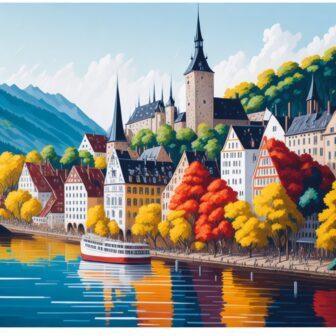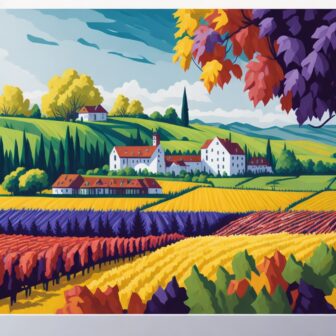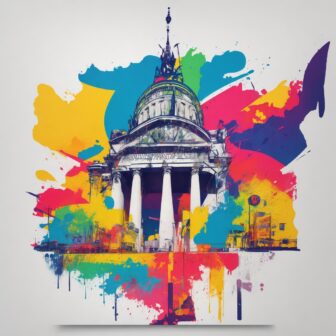1 Day Itinerary in Berlin
This one day itinerary in Berlin is a walk that runs from the main train station to Alexanderplatz and covers around six kilometers. Without going to museums or doing extensive tourism, you may complete it easily in a single day.
Berlin Train Station
Between the Chancellery and the Paul-Löbe-Haus, whose enormous glass front the Chancellery is mirrored in, you exit the train station on the south side, Washingtonplatz, and cross the pedestrian bridge in the direction of the Reichstag. Turn left and proceed to the Spree past the Paul-Löbe-Haus.
Elisabeth-Lüders-Haus
You can see the Elisabeth-Lüders-Haus, which houses the parliamentary library, and the two bridges that link the old West and East Berlin on the other side of the river. At this time, there was just one wall on the other bank, and the river served as the second barrier. The wall here followed the Spree for a while. Crosses on the sand serve as a reminder of failed attempts to flee. Retract your steps and pass the Reichstag.
Tiergarten
In order to get to the Brandenburg Gate, use the diagonal path through the Tiergarten. Behind the wall on your left is where you’ll find the monument to the murdered Sinti and Roma.
Pariser Platz
You pass the sunken cobblestone strip that indicates the wall’s course as you make your way to the entrance. Up until 1989, Pariser Platz was in ruins and ablaze, and the gate stood in the center of a hostile landscape between the East and the West. The gate, which Carl Gotthard von Langhans constructed between 1788 and 1791, replaced an earlier city gate in the customs wall along the route to Brandenburg. Sitting in the side wings were the customs officers. The Acropolis in Athens served as the model for Langhan.
The Quadriga
The Quadriga from Schadow was taken to Paris in 1806 under Napoleon’s rule, but Blücher’s troops found it still packed in crates in 1814, loaded it up and brought it back. After the Paris adventure, people simply called her the tit-for-tat. From here you can see the victory column in the Tiergarten, from which you can also enjoy a great view once you have climbed it. Up close you can see the angel that appears in Wim Wender’s “The Sky over Berlin”.
Frank Gehry’s DZ-Bank
With the exception of the former Academy of Arts structures, which were incorporated into their new structure, Pariser Platz was completely reconstructed. There are noteworthy architectural features, a canteen, a book shop, and varying exhibitions available. Frank Gehry’s DZ-Bank is the home to the right. Expressionist architecture is concealed beneath the sober façade in accordance with the contrasts principle. The whale statue in the courtyard rises out of the water and holds a tiny conference space in its mouth when it is available (and no events or celebrations are happening).
Brandenburg Gate and the Holocaust Memorial
You reach the Holocaust Memorial in honor of the murdered European Jews as you pass through the Brandenburg Gate on your way back, the American Embassy on your left. On a wavy ground, more than 2700 stele stand. The documentation center, which includes a database, is located towards the end of the field of stelae. Anytime during the day is acceptable for the free visit.
There is a small memorial for the murdered gay across the street, on the right in the Tiergarten.
Potsdamer Platz
You can’t miss Potsdamer Platz if you keep moving in the direction of the buildings. Years ago, Potsdamer Platz was the busiest plaza in the city, but the street crossing had been in a no-man’s land for that time.
RELATED - How about a trip to Potsdam:
Best Places to Visit in Potsdam
Verkehrsturm
Admire the “Verkehrsturm,” the country of Germany’s first traffic light, constructed in 1924. Here, a police officer controlled the traffic while keeping watch out the window. Franz Hessel’s 1929 book “Walking in Berlin” has a lovely description of the tower and the other pleasure centers on Potsdamer Platz.
Hotel Esplanade
Along the street there are pieces of wall that mark the course of the wall. Behind, in front of and in Helmut Jahn’s Sony Center you can see the walls of a suite from the Hotel Esplanade behind glass on the right. In the 1920s it was one of the most famous hotels in the city. Largely destroyed, the ruins also served as a film set in “Himmel über Berlin”, in which you can also see the whole area around Potsdamer Platz as it looked in the mid-1980s, i.e. empty.
Kollhoffhaus
You keep going to a building called the Kollhoffhaus that makes you think of Chicago in the winter of the 1930s. Elevators leading to Panoramapunkt are located here, and two surrounding terraces guarantee a stunning view.
Marlene-Dietrich-Platz
The annual film festival takes place in February, in the Marlene-Dietrich-Platz where everyone congregates to watch movies, read the press, and take in the sights.
In this huge space, Renzo Piano and the architects he guided from all over the world have immortalized themselves. Terracotta is used to cover every building, giving the many styles of architecture a unified look and warm hues.
RELATED:
Best Places to Visit in Berlin
1 Day Itinerary in Berlin
Things to Do in Berlin for Young Adults
Top Thermal Baths in Berlin
Best Places to Go Shopping in Berlin
Best Boutique Hotels in Berlin
Martin-Gropius-Bau
The Martin-Gropius-Bau is on the right when you make a left turn into Niederkirchner Strasse from Stresemannstrasse. A real section of wall lies hidden behind, severely damaged by wallpeckers and now enclosed. The free Topography of Terror museum is located on the grounds beside the Gestapo’s former headquarters. Many portraits as well as images of the SS, Gestapo, persecution, extermination, the end of the war, and the post-war period are displayed.
The Ministry of Finance
The Ministry of Finance, originally known as the Reich Ministry of Aviation, is located on the left. The globe balloon, which you can ride in calm weather to a height of 150 meters, and the Trabis, which you may drive yourself on a Trabi safari, are farther straight ahead.
Checkpoint Charlie
The spy novels “The Spy Who Came in from the Cold” by John le Carré and the James Bond movie “Octopussy” both take place at the former border crossing known as Checkpoint Charlie. Pictures of the Cold War and the fall of the Berlin Wall can be found everywhere.
Gendarmenmarkt
The Wall Museum has a smorgasbord of getaway cars as well as many more images. The most picturesque square in Berlin, Gendarmenmarkt, lies on the left after continuing up Friedrichstraße until Mohrenstraße. From there, turn right and walk along Markgrafenstraße to reach it. Between the German and French cathedrals is a concert hall that serves as a reminder of the Huguenot immigration.
St. Hedwig’s Cathedral
You will pass the restored St. Hedwig’s Cathedral if you turn right on Französische Straße and then left again. A floor-mounted window on Bebelplatz that displays an empty library in remembrance of the 1933 book burning. Old Fritz is depicted in Rauch’s equestrian statue riding his beloved horse Condé in the middle of the Unter den Linden Boulevard, which is in front of you.
The Humboldt UniversitY
The Humboldt University, which stands across the street, is where Karl Marx, Otto von Bismarck, and Albert Einstein attended college and where Johann Gottlieb Fichte taught. In the Neue Wache, next to it, in the direction of Alexanderplatz, is a Käthe Kollwitz sculpture.
Museum Island
The German Historical Museum and the Armory come next. I.M. Pei’s extension, the glass snail with the spherical entrance hall and games involving light and shadow, is visible on the left, at its back. Turn around and cross the bridge in the direction of Museum Island.
Alexanderplatz
You complete your one day itinerary in Berlin on the magnificent Alexanderplatz by passing through the Lustgarten and the television tower.






